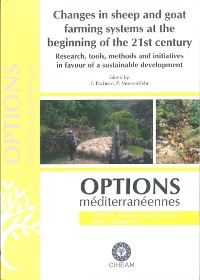| Article précédent | p. 313-317 | Article suivant |
Bilans énergétiques en élevage ovin viande : quelles voies d'adaptation pour une meilleure maîtrise ?
Face aux préoccupations actuelles en termes de ressources énergétiques et d'émissions de gaz à effet de serre, nous cherchons à évaluer les principales voies d'amélioration des bilans énergétiques en élevage ovin viande. Ce travail est réalisé par modélisation, grâce à un simulateur du fonctionnement et des performances des systèmes d'élevage ovin viande intégrant un module de calcul de bilan énergétique. Après le chiffrage des bilans énergétiques basé sur 4 groupes typologiques, trois adaptations sont étudiées sur le système mixte (polyculture élevage, 130 ha dont 40 ha de cultures, 610 brebis) : amélioration de l'autonomie alimentaire (augmentation de la part des cultures autoconsommées), introduction de légumineuses dans la rotation (suppression des fertilisants azotés de synthèse), production d'huile carburant (colza) avec utilisation des tourteaux par le troupeau. L'adaptation la plus favorable correspond à la suppression de la fertilisation azotée de synthèse. Les adaptations successives permettent de passer d'une consommation d'énergie de 2,2 équivalent litres de fuel (EQF) par kg de carcasse d'agneau produit à 0,98 après optimisations ; l'efficacité énergétique (EE) passe alors de 0,42 à 0,93. Enfin, l'impact énergétique de 4 facteurs modifiant le fonctionnement du troupeau et la structure de l'exploitation est étudié : productivité numérique du troupeau, poids des agneaux, type de parcellaire, taille du troupeau. Les 2 premiers facteurs ont un impact positif très favorable sur les critères d'EE.
Within the context of climate change and natural resource depletion, limiting energy use and greenhouse gas emissions is a key issue. This paper focus on energy balance of farms specialised in meat sheep production. Objectives are first to propose ways to improve energy balance through global change in farm management, then to assess the impact of some key factors. A meat sheep farm model is used to simulate farm outcomes related to sheep production, economic results and energy balance. Farmer's practices and farm structural characteristics are set to correspond to a typical farm (Mixed system: 130 ha of which 40 ha crops, and 610 ewes). Three adaptations of this system are studied: improvement of food self-sufficiency (increased proportion of self produced concentrate), introduction of legume crops into the rotation to reduce nitrogen fertilizers use, production of fuel-oil from rapeseed with use of the oil cakes by the flock. The most favourable adaptation corresponds to the removal of the nitrogen fertilizers. Energy consumption decreases from 2.2 equivalent litres of fuel by kg carcass of lamb produced to 0.98 after the three optimizations and the energy efficiency rises from 0.42 to 0.93. Then, the impact of 4 factors modifying the functioning of the flock and the structure of the farm are studied on the base of the mixed system: numerical productivity of the flock, weight of the lambs, plots structure, and importance of the flock. The first 2 factors have a very favourable positive impact on the criteria of energy effectiveness.
- [ Afficher ]
- [ Télécharger ]
- [ Exporter la citation ]
Vous pouvez télécharger la citation au format :
- [ Imprimer ]
-
Mots-clés
ANIMAL A VIANDE, BILAN ENERGETIQUE, EFFICACITE, MODELE DE SIMULATION, OVIN, SYSTEME D'ELEVAGE, SYSTEME D'EXPLOITATION AGRICOLECiter cet article
Benoit M., Laignel G. Bilans énergétiques en élevage ovin viande : quelles voies d'adaptation pour une meilleure maîtrise ?. In : Pacheco F. (ed.), Morand-Fehr P. (ed.). Changes in sheep and goat farming systems at the beginning of the 21st century : research, tools, methods and initiatives in favour of a sustainable development . Zaragoza : CIHEAM / DRAP-Norte / FAO, 2009. p. 313-317. (Options Méditerranéennes : Série A. Séminaires Méditerranéens; n. 91). Proceedings of the Seminar of the Subnetwork on Production Systems of the FAO-CIHEAM Network for Research and Development in Sheep and Goats, 2007/11/15-17, Ponte de Lima (Portugal). http://om.ciheam.org/om/pdf/a91/00801164.pdf



